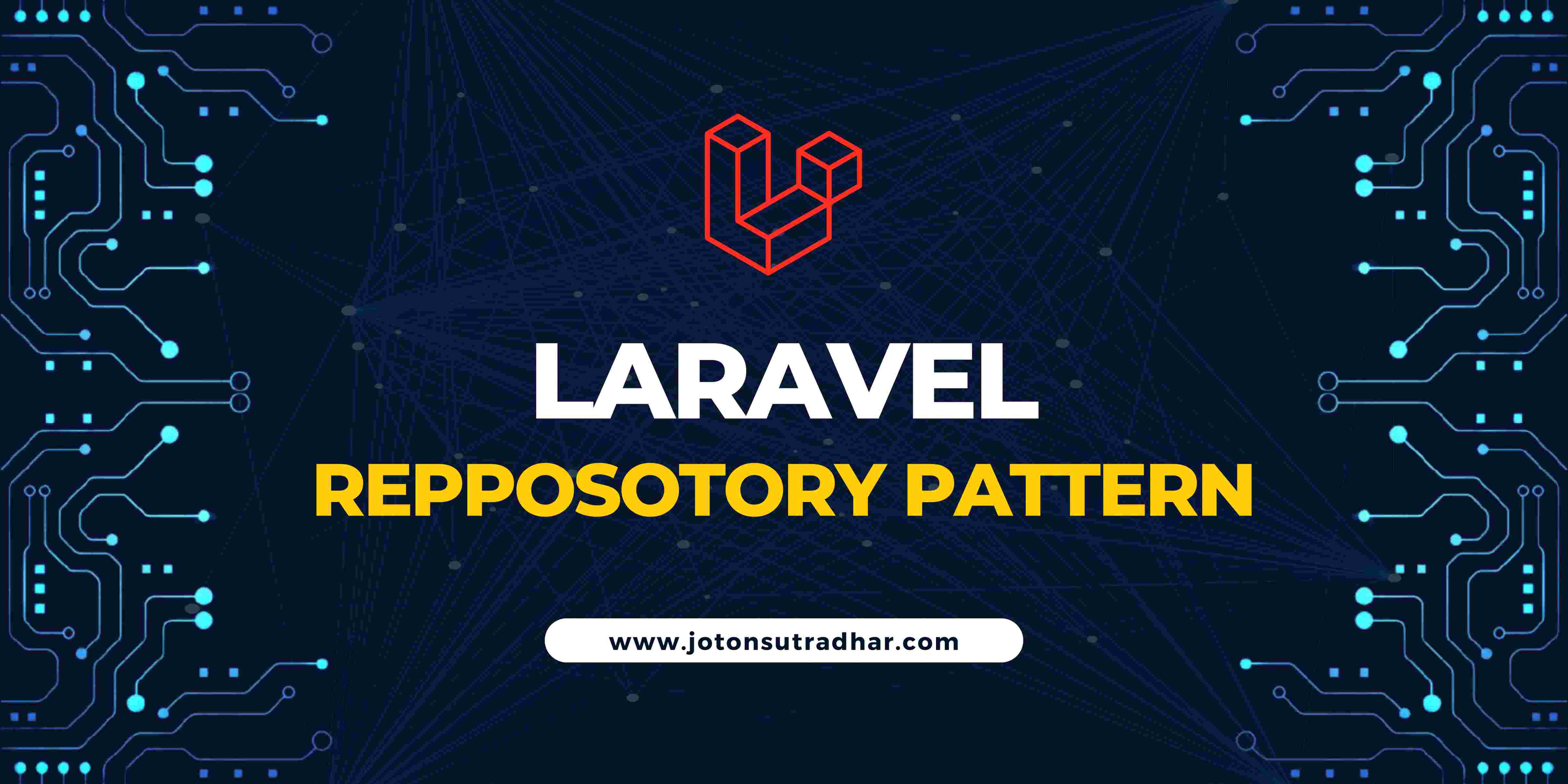Creating A Laravel CRUD Application With The Repository Pattern

Laravel is a powerful PHP framework that simplifies web application development. When building a CRUD (Create, Read, Update, Delete) application, using the Repository Pattern can make your code cleaner, more maintainable, and easier to test. In this blog, we'll guide you through setting up a Laravel project with the Repository Pattern for a CRUD operation.
Project Structure
laravel-crud-repository/
│── app/
│ ├── Http/
│ │ ├── Controllers/
│ │ │ ├── ProductController.php
│ ├── Models/
│ │ ├── Product.php
│ ├── Providers/
│ │ ├── RepositoryServiceProvider.php
│ ├── Repositories/
│ │ ├── Interfaces/
│ │ │ ├── ProductRepositoryInterface.php
│ │ ├── Eloquent/
│ │ │ ├── ProductRepository.php
│── database/
│ ├── migrations/
│ │ ├── xxxx_xx_xx_create_products_table.php
│── routes/
│ ├── api.php
│── .env
│── composer.json
│── artisan
Step 1: Install Laravel
If you haven't installed Laravel yet, run the following command to create a new Laravel project:
composer create-project laravel/laravel laravel-crud-repository
cd laravel-crud-repository
composer create-project laravel/laravel laravel-crud-repository
cd laravel-crud-repositoryStep 2: Configure Database
Update your .env file with your database credentials:
DB_CONNECTION=mysql
DB_HOST=127.0.0.1
DB_PORT=3306
DB_DATABASE=crud_repository
DB_USERNAME=root
DB_PASSWORD=Run migrations to set up the database:
php artisan migrateStep 3: Create a Model and Migration
Generate a model with migration for a sample entity, like Product:
php artisan make:model Product -mModify the migration file in database/migrations/xxxx_xx_xx_xxxxxx_create_products_table.php:
public function up()
{
Schema::create('products', function (Blueprint $table) {
$table->id();
$table->string('name');
$table->text('description')->nullable();
$table->decimal('price', 8, 2);
$table->timestamps();
});
}Run the migration:
php artisan migrateStep 4: Implement the Repository Pattern
1. Create the Interface in Interfaces Folder
Create a new folder app/Repositories/Interfaces/ and then the ProductRepositoryInterface.php file:
namespace App\Repositories\Interfaces;
interface ProductRepositoryInterface
{
public function getAll();
public function getById($id);
public function create(array $data);
public function update($id, array $data);
public function delete($id);
}2. Implement the Repository in the Eloquent Folder
Create the Eloquent folder inside Repositories/ and create ProductRepository.php:
namespace App\Repositories\Eloquent;
use App\Models\Product;
use App\Repositories\Interfaces\ProductRepositoryInterface;
class ProductRepository implements ProductRepositoryInterface
{
public function getAll()
{
return Product::all();
}
public function getById($id)
{
return Product::findOrFail($id);
}
public function create(array $data)
{
return Product::create($data);
}
public function update($id, array $data)
{
$product = Product::findOrFail($id);
$product->update($data);
return $product;
}
public function delete($id)
{
return Product::destroy($id);
}
}3. Bind the Repository in the Service Provider
Run:
php artisan make:provider RepositoryServiceProviderModify app/Providers/RepositoryServiceProvider.php:
namespace App\Providers;
use Illuminate\Support\ServiceProvider;
use App\Repositories\Interfaces\ProductRepositoryInterface;
use App\Repositories\Eloquent\ProductRepository;
class RepositoryServiceProvider extends ServiceProvider
{
public function register()
{
$this->app->bind(ProductRepositoryInterface::class, ProductRepository::class);
}
}Register the provider in config/app.php:
App\Providers\RepositoryServiceProvider::class,Step 5: Create a Controller and Inject the Repository
Modify app/Http/Controllers/ProductController.php:
namespace App\Http\Controllers;
use App\Repositories\Interfaces\ProductRepositoryInterface;
use Illuminate\Http\Request;
class ProductController extends Controller
{
protected $productRepository;
public function __construct(ProductRepositoryInterface $productRepository)
{
$this->productRepository = $productRepository;
}
public function index()
{
return response()->json($this->productRepository->getAll());
}
public function store(Request $request)
{
$data = $request->validate([
'name' => 'required|string|max:255',
'description' => 'nullable|string',
'price' => 'required|numeric',
]);
return response()->json($this->productRepository->create($data));
}
public function show($id)
{
return response()->json($this->productRepository->getById($id));
}
public function update(Request $request, $id)
{
$data = $request->validate([
'name' => 'sometimes|string|max:255',
'description' => 'nullable|string',
'price' => 'sometimes|numeric',
]);
return response()->json($this->productRepository->update($id, $data));
}
public function destroy($id)
{
return response()->json(['deleted' => $this->productRepository->delete($id)]);
}
}Step 6: Define API Routes
Modify routes/api.php:
use App\Http\Controllers\ProductController;
Route::apiResource('products', ProductController::class);Step 7: Test the API
Run the Laravel development server:
php artisan serveTest using Postman or cURL:
Get all products:
curl -X GET http://127.0.0.1:8000/api/productsCreate a product:
curl -X POST -H "Content-Type: application/json" \
-d '{"name": "Laptop", "description": "A gaming laptop", "price": 1500}' \
http://127.0.0.1:8000/api/productsFinal Thoughts
By organizing repositories into separate Interfaces and Eloquent folders, this approach makes your Laravel project more scalable and structured. This Repository Pattern ensures loose coupling, making it easier to switch to a different data source in the future.
Now you have a Laravel project following the Repository Pattern for CRUD operations! 🚀 Let me know if you have any questions!
Related Blogs
Integrating payment gateways like Stripe, SSLCommerz, or Bkash is a common need in web development. But if not done right, it can lead to messy, repeated code and poor resource management. In this blog, we’ll explore how to implement a clean, scalable, and reusable payment system using the Singleton Pattern, Strategy Pattern, and Dependency Injection in Laravel.
Alright, Laravel developers, let's talk shop. We love Laravel for its elegance, convention over configuration, and how quickly it lets us build. But as our applications grow, even in a framework as opinionated as Laravel, we can fall into traps: repeating the same logic across different "service" classes, inconsistent data handling, or struggling to manage complex workflows.
Debugging is one of the most crucial skills every developer must master, yet it's often overlooked in formal education. Whether you're a beginner writing your first "Hello World" program or a seasoned developer working on complex enterprise applications, debugging will be your constant companion throughout your coding journey.